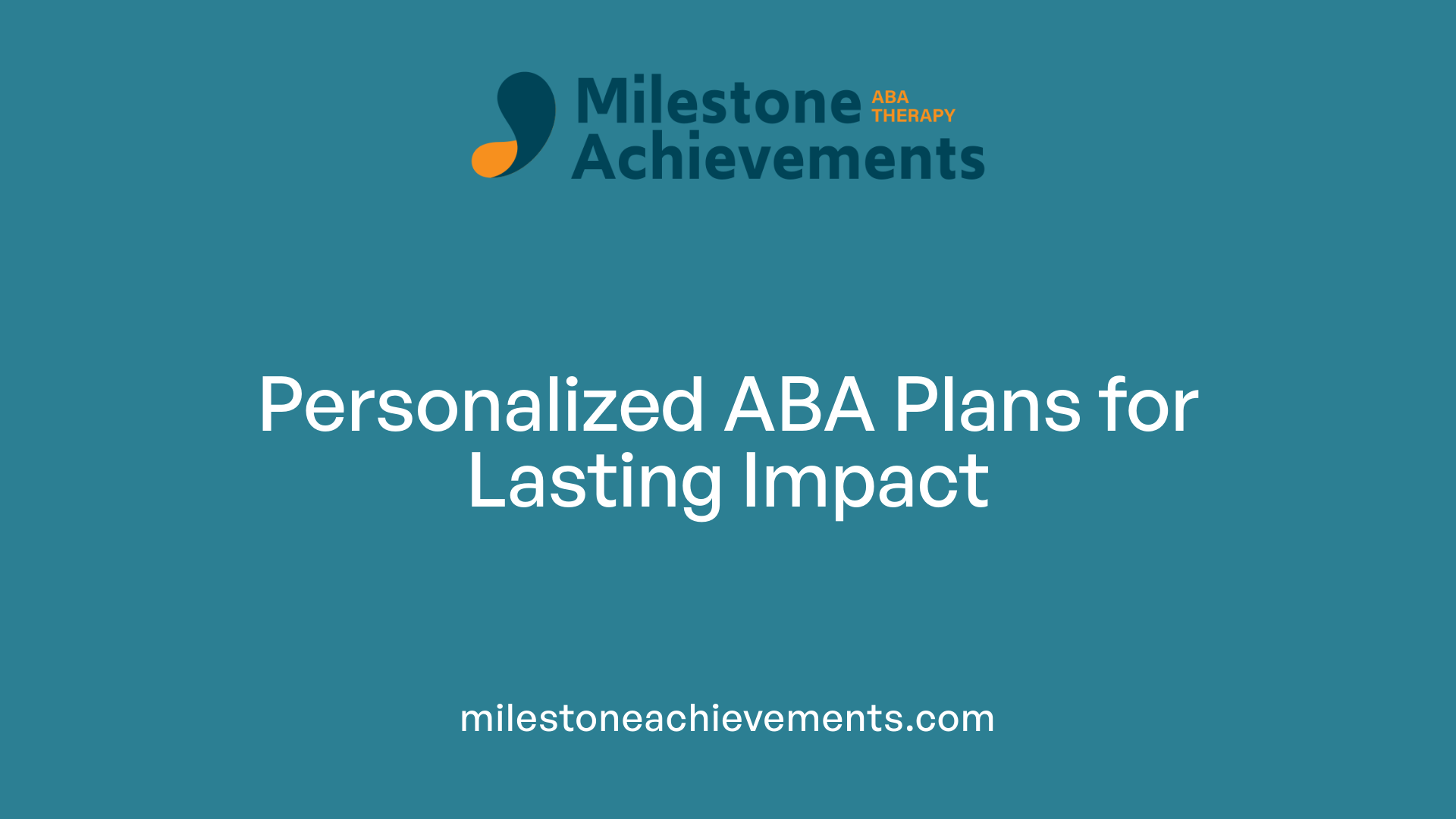How ABA Therapy Supports Positive Behavior Changes
Unlocking Positive Growth with Evidence-Based Interventions

Exploring the Foundations of ABA Therapy for Lasting Behavioral Change
Applied Behavior Analysis (ABA) is a scientifically validated approach that systematically applies principles of learning to bring about meaningful and lasting behavioral improvements. Recognized globally as the gold standard, particularly in supporting children with autism spectrum disorder (ASD), ABA therapy is rooted in the science of behaviorism. This approach prioritizes understanding how environmental factors influence behavior, enabling tailored interventions that promote positive skills and reduce maladaptive behaviors. Over decades of research, ABA has evolved to incorporate natural, person-centered, and ethical practices, ensuring it supports individual autonomy and well-being while fostering significant developmental gains.
Core Principles and Techniques of ABA Therapy

What is ABA therapy and how does it facilitate behavioral improvements?
ABA therapy, or Applied Behavior Analysis, is a scientifically validated approach grounded in the principles of behaviorism. It involves understanding how environmental factors influence behavior and applying systematic strategies to encourage positive changes.
The core of ABA includes techniques like reinforcement, where desirable behaviors are rewarded to encourage their recurrence. For example, praising a child for sharing toys increases the likelihood they'll share again. Conversely, punishment can be cautiously used to reduce harmful or unwanted behaviors by introducing aversive consequences or removing preferred stimuli.
Motivation plays a vital role; therapists assess what motivates each individual and tailor interventions to keep them engaged. Central to ABA are the ABCs—Antecedents, Behaviors, and Consequences—which guide the understanding of triggers, actions, and outcomes to shape behavior effectively.
Data collection is an essential component, with therapists meticulously tracking progress through observations and measurements. This data allows for ongoing adjustments to customize the therapy to each person's unique needs and responses.
ABA programs are highly individualized, developed by qualified behavior analysts, or Board Certified Behavior Analysts (BCBAs). These professionals perform assessments to identify skills gaps and preferences, designing targets in areas like communication, social skills, daily living, and academics.
Overall, ABA facilitates behavioral improvement by integrating evidence-based techniques, involving caregivers, and constantly refining interventions based on systematic data. This personalized and scientific approach helps individuals acquire valuable skills, reduce problematic behaviors, and improve overall quality of life.
Tailoring Interventions for Individual Needs

What are the benefits and effectiveness of ABA therapy in promoting positive behaviors?
ABA therapy is a scientifically validated approach that applies principles of learning to encourage positive behavioral changes. Its primary focus is to increase helpful skills such as communication, social interactions, attention, memory, and daily life abilities. At the same time, ABA is effective at reducing harmful or impeding behaviors, making it a comprehensive method for supporting individuals with developmental challenges, especially autism.
One of the strengths of ABA is its tailored nature. Each program is personalized based on thorough assessments carried out by qualified behavior analysts. These assessments help identify individual strengths, preferences, and specific areas needing improvement. The treatment plans are then designed with clear, small, and measurable goals, which often include communication, social skills, self-care, motor development, and academic skills.
Ongoing monitoring and data collection are fundamental in ABA. They enable practitioners to measure progress objectively and make data-driven adjustments to the intervention strategies. This continuous assessment ensures that each individual’s program remains effective and relevant, optimizing outcomes.
Techniques like positive reinforcement, which reward desirable behaviors, and careful analysis of antecedents and consequences, are central to ABA therapy. These techniques are integrated into natural and structured learning environments, whether at home, school, or in clinical settings.
The versatility of ABA allows it to be implemented across various age groups and settings. Early intervention programs can lead to long-lasting improvements, including better cognition and adaptive skills. Long-term, intensive ABA therapy has shown to significantly enhance overall functioning and quality of life.
Research, including meta-analyses, consistently supports the effectiveness of ABA therapy. It is recognized as a best-practice intervention for children with autism and is often more effective than standard care. By emphasizing personalized treatment plans, ABA not only promotes positive behaviors but also encourages independence and social participation.
In summary, ABA therapy offers numerous benefits. Its scientific foundation, individualized approach, and focus on positive behavior change make it a powerful tool for fostering development and enhancing life quality for many individuals.
Common Techniques and Strategies in ABA
What are common ABA therapy techniques?
Applied Behavior Analysis (ABA) employs a variety of evidence-based methods tailored to individual needs. Some of the most widely used techniques include positive reinforcement, prompting, task analysis, and systematic skill acquisition procedures.
Positive reinforcement is a foundational technique where desired behaviors are immediately rewarded with verbal praise, tangible items, or access to preferred activities. This encouragement increases the likelihood that these behaviors will be repeated. For example, giving a child a toy or complimenting them after they share with a peer reinforces sharing as a positive behavior.
Prompting involves providing cues or assistance to help children perform targeted behaviors. These prompts can be verbal, visual, physical, or gestural, fading over time as independence grows.
Task analysis breaks down complex skills into smaller, manageable steps. This systematic approach makes learning more approachable and measurable. For instance, teaching dressing might begin with reinforcing the action of pushing arms through sleeves before progressing to buttons.
Discrete Trial Training (DTT) is a structured teaching method that utilizes the ABC model—antecedent, behavior, consequence. In DTT, each learning trial is carefully planned and executed, focusing on specific skills and closely monitoring progress.
These techniques are integrated into comprehensive programs that aim to promote functional skills, reduce problem behaviors, and support meaningful learning tailored to each child's unique profile.
| Technique | Description | Example |
|---|---|---|
| Positive Reinforcement | Rewards to encourage desired behaviors | Giving tokens or praise after completing a task |
| Prompting | Assistance or cues that guide behavior | Using gestures or visuals to prompt a child to answer |
| Task Analysis | Breaking skills into smaller steps | Teaching brushing teeth step-by-step |
| Discrete Trial Training | Structured teaching using ABA's ABC model | Repeating a prompt until correct, then reinforcing |
| Naturalistic Teaching | Embedding learning in everyday activities and play | Teaching requesting by toy play |
Overall, these methods create a personalized, engaging learning environment that promotes lasting behavioral change while addressing individual strengths and challenges.
For more detailed insights, searching "ABA techniques and strategies" can provide additional information and practical application ideas.
Promoting Positive Behavior Change and Skill Development

How does ABA therapy promote positive behavior change?
ABA therapy fosters positive behavior modification by methodically teaching new skills and diminishing harmful or disruptive behaviors. Its foundation lies in the principles of behaviorism, particularly operant conditioning, which emphasizes reinforcement — rewarding desired behaviors to encourage their repetition.
The process involves identifying specific behaviors, breaking them into manageable steps, and applying data-driven techniques to monitor progress. Techniques such as positive reinforcement are central, making learning engaging and motivating for children.
Initially, ABA programs focused on structured, adult-led methods, but now they incorporate more natural, person-centered strategies. These approaches respect the child's preferences and promote learning within meaningful contexts.
A broad spectrum of skills is targeted, including communication, social interaction, daily living, and academic abilities. By consistently applying reinforcement and carefully tracking outcomes, ABA helps children develop lasting improvements in their behavior and independence.
Extensive research over decades affirms ABA's effectiveness, especially for children on the autism spectrum. It has demonstrated that, through tailored interventions, children can achieve significant gains in communication, social skills, and self-care.
Additionally, modern ABA emphasizes collaboration with families and caregivers, ensuring that interventions are ethical, respectful, and customized to individual needs. This teamwork enhances the likelihood of sustained, meaningful progress, ultimately improving the child's quality of life.
Role of Positive Behavior Support (PBS) within ABA Framework

What is positive behavior support in ABA?
Positive behavior support (PBS), which includes Positive Behavioral Interventions and Supports (PBIS), is a practical application of ABA principles aimed at creating environments where positive behaviors are encouraged, and challenging behaviors are minimized. It is an evidence-based, continuous process that relies on systematic data collection and analysis.
PBIS and PBS are designed to develop supportive, predictable, and fair settings, especially in educational and therapeutic contexts. The approach helps reduce disruptive or harmful behaviors by proactively addressing the underlying causes and promoting adaptive skills.
How does PBS work across different support levels?
A core aspect of PBS within ABA involves a tiered support system, often represented as three levels:
| Tier | Description | Focus Areas | Examples |
|---|---|---|---|
| Tier 1 | Universal supports for all individuals | Establishing expectations, positive routines | Clear rules, visual schedules, general reinforcement strategies |
| Tier 2 | Targeted supports for some individuals | Additional strategies for those needing more support | Social skills groups, small group interventions |
| Tier 3 | Intensive, personalized supports for specific needs | Customized interventions based on detailed assessment | One-on-one behavior plans, functional behavioral assessments |
This tiered approach ensures that every individual receives appropriate supports, with escalation based on individual needs.
What strategies are used to implement PBS?
Implementing PBS involves several proactive strategies:
- Setting clear, consistent expectations and routines.
- Creating a positive environment by reinforcing desirable behaviors.
- Using visual cues like schedules and timers to prepare children for transitions.
- Incorporating environmental modifications to reduce triggers for challenging behaviors.
- Developing individualized plans based on thorough functional assessments.
Data collection plays a vital role in monitoring progress and making informed adjustments. Continual analysis of behavior patterns helps refine interventions, ensuring they are effective and meaningful.
How do environmental changes support positive behaviors?
Environmental modifications form a cornerstone of PBS strategies. These include adjustments like sensory-friendly spaces, organized materials, and visual aids to promote independence. Such changes make environments more predictable and less overwhelming, encouraging engagement and positive interactions.
Why is collaboration important?
Successful PBS implementation depends on teamwork. Regular communication among educators, therapists, parents, and the individual ensures consistency and supports generalization of skills. Collecting data together and reviewing progress allows for ongoing, collaborative refinement of the support plans.
| Aspect | Description | Benefits | Example |
|---|---|---|---|
| Data Monitoring | Track behaviors and intervention effectiveness | Informed decision-making | Behavior charts, frequency counts |
| Environmental Modification | Adjust spaces and routines to reduce triggers | Creates supportive, predictable settings | Quiet corners, visual schedules |
| Tiered Support | Support at different levels based on need | Personalized, effective behavioral interventions | Customized plans, escalated supports |
Overall, PBS within ABA aims to build positive, supportive environments tailored to individual needs, fostering meaningful progress and well-being.
Creating an Environment that Supports Learning and Adaptation

How can ABA techniques be applied at home and in daily settings to reinforce positive behaviors?
Applying ABA strategies in everyday life is essential for reinforcing positive behaviors and promoting lasting change. One of the most effective methods is creating structured environments that provide predictability and clarity. Using visual schedules helps children understand daily routines and what to expect next, reducing anxiety and encouraging independence.
Transition cues like countdown timers or visual signals prepare children for upcoming changes, making transitions smoother and less stressful. These cues help children feel more secure and in control during routine shifts, whether moving from playtime to mealtime or preparing to leave the house.
Reinforcing desirable behaviors immediately with praise, tokens, or other rewards motivates children to repeat these actions. Such positive reinforcement fosters a sense of achievement and encourages continued progress.
Teaching children coping strategies, such as deep breathing exercises, self-calming techniques, or using sensory tools, supports emotional regulation. These skills help children manage frustration, anxiety, or resistance to change, which promotes resilience and adaptability.
Social stories and role-playing are valuable tools for preparing children for new or challenging situations. These strategies help children understand appropriate responses and set expectations, easing fears and reducing problem behaviors.
To ensure behaviors are maintained across settings, it’s crucial to generalize learned skills beyond the therapy environment. This can be achieved by practicing new behaviors in various contexts and ensuring consistency in responses.
Safety is paramount when applying ABA techniques at home. Establishing safe spaces, monitoring interactions, and setting appropriate boundaries are necessary to support effective learning.
In combination, these methods create a supportive, predictable, and positive environment for children. They foster growth by reinforcing desirable behaviors, teaching resilience, and ensuring that skills are usable in daily life.
Long-Term Benefits and Ethical Considerations
What are the long-term benefits of ABA, and how does ethical practice influence its application?
Applied Behavior Analysis (ABA) offers notable long-term benefits, especially for individuals with autism and developmental disabilities. With consistent application, ABA can lead to lasting improvements in communication skills, social interactions, independence, and adaptive functioning. Children and adults who undergo intensive and personalized ABA therapy often experience enhanced quality of life, greater self-sufficiency, and better integration into community settings.
These benefits are optimized when ABA is practiced ethically. Ethical implementation emphasizes individualized care, ensuring that interventions respect each person's unique strengths, preferences, and needs. It avoids harmful practices such as punishment, overgeneralization, or promoting neurotypical behaviors at the expense of individual identity.
Practicing ethically involves ongoing assessment and data collection to monitor progress and adjust strategies as needed. Transparency with families and individuals fosters trust and collaboration, making sure that goals align with personal values and desires. Professionals committed to ethical standards also advocate for culturally sensitive practices, respecting diverse backgrounds and minimizing biases.
Community involvement plays a role in ethical ABA, as engaging families, caregivers, and community members ensures support systems are aligned and respectful. Regular reflection on practice methods encourages practitioners to stay current with research and societal norms, ensuring interventions remain safe, effective, and meaningful.
Ultimately, ethical ABA supports not only immediate behavior improvements but also promotes autonomy, self-empowerment, and social inclusion. Through a respectful and individualized approach, ABA can foster significant, long-lasting positive changes that enhance life overall.
Embracing a Compassionate, Evidence-Based Approach
ABA therapy, grounded in scientific research and ethical principles, offers a powerful avenue for supportive, individualized behavioral change. Its focus on positive reinforcement, naturalistic learning, and collaboration with families and professionals has consistently demonstrated its effectiveness in helping children, especially those with autism, develop essential skills. By creating structured, supportive environments and applying proven techniques, ABA promotes not only immediate improvements but also long-lasting, meaningful growth. As the field evolves, mindful adherence to ethical standards and inclusivity ensures ABA remains a respectful and empowering approach that fosters autonomy, resilience, and social integration for all individuals.
References
- Applied Behavior Analysis (ABA) | Autism Speaks
- How ABA Therapy Influences Positive Behavior Change
- Applied Behavior Analysis: A Path to Positive Behavior Change
- Positive behavior support: 6 steps to success | Autism Resources
- How ABA Therapy Can Help Children with Autism Thrive
- Applied Behaviour Analysis (ABA) and autistic children
- Applied Behavior Analysis (ABA) | Autism Speaks
- Applied Behavioral Analysis (ABA) - Autism Speaks







